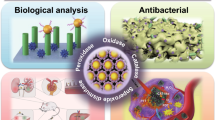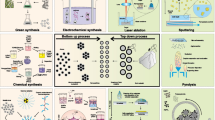Abstract
We report in this work the magnetic, morphological, and heating properties of magnetite nanoparticles (MNPs), which were synthesized by using different molar aqueous solutions of citric acid and the combustion method. When the content of citric acid (molarity) is increased from 0.5 M to 2 M, the average size of MNPs decreased from 7.3 ± 1 nm to 6.9 ± 1 nm according to the microscopy analysis. Also, the analysis by x-ray diffraction confirmed that all the MNPs presented a cubic phase. On the other hand, the magnetic measurements of the magnetite nanoparticles showed that they are superparamagnetic, since their coercivity values are in the range of 3–9 Oe. The MNPs were subjected to a magnetic field of 0.1 T while the frequency was varied from 87 kHz to 340 kHz. After this, the specific absorption rate (SAR) was calculated (this parameter is relevant because it is related to the heating efficiency of the nanoparticles). Consequently, the highest SAR value (179.8 W/g) was obtained at a frequency of 87 kHz and the lowest SAR value (114.9 W/g) was obtained at a frequency of 340 kHz. Furthermore, the SAR values were correlated with the Fe2+/Fe3+ ratio and found that the increase of this ratio enhances the heating efficiency of the magnetite nanoparticles. Also, the maximum heating temperature of the MNPs increases with the molarity of the citric acid (at the same frequency of applied magnetic field). In general, the highest values of heating temperature (61.2–66.4 °C) were produced by the MNPs subjected to a magnetic field of 87 Hz. We also evaluated the toxicity of the MNPs by obtaining their viability % values and those were in the range of 86–95%, which means that they are non-toxic and biocompatible. We finally achieved a proof of concept (in vitro experiments) and attached MNPs to colon cancer cells. Subsequently, these were subjected to a magnetic field of 0.1 T at a frequency of 87 kHz and could destroy the cancer cells (as confirmed by optical images). Hence, the results of this research demonstrate that the MNPs studied here are promising candidates for hyperthermia treatment.
Graphical Abstract









Similar content being viewed by others
References
P. Allia, G. Barrera, and P. Tiberto, J. Magn. Magn. Mater. Nanoscale 12, 6360 (2020).
I. Obaidat, V. Narayanaswamy, S. Alaabed, S. Sambasivam, and C. Muralee Gopi, Magnetochemistry 5, 67 (2019).
D. Chang, M. Lim, J. Goos, R. Qiao, Y. Ng, F. Mansfeld, M. Jackson, T. David, and M. Kavallaris, Front. Pharmacol. 9, 831 (2018).
S. Mallesh, D. Narsimulu, and K. Kim, Phys. Lett. Sect. A Gen. At. Solid State Phys. 384, 1 (2020).
M. Horny, J. Gamby, V. Dupuis, and J. Siaugue, Nanomaterials 11, 1 (2021).
Y. Gu, M. Yoshikiyo, A. Namai, D. Bonvin, A. Martinez, R. Piñol, P. Téllez, N. Silva, F. Ahrentorp, C. Johansson, J. Marco-Brualla, R. Moreno-Loshuertos, P. Fernández-Silva, Y. Cui, S. Ohkoshi, and A. Millán, RSC Adv. 10, 28786 (2020).
M. Salimi, S. Sarkar, R. Saber, H. Delavari, A. Alizadeh, and H. Mulder, Cancer Nanotechnol. 9, 1 (2018).
O. Lemine, K. Omri, M. Iglesias, V. Velasco, P. Crespo, P. De La Presa, L. El Mir, H. Bouzid, A. Yousif, and A. Al-Hajry, J. Alloys Compd. 607, 125 (2014).
S. Munjal, N. Khare, B. Sivakumar, and D. Nairakthikumar, J. Magn. Magn. Mater. 477, 388 (2019).
M. De Sousa, M. Fernández Van Raap, P. Rivas, P. Mendoza Zélis, P. Girardin, G. Pasquevich, J. Alessandrini, D. Muraca, and F. Sánchez, J. Phys. Chem. C 117, 5436 (2013).
G. Niraula, J. Coaquira, G. Zoppellaro, B. Villar, F. Garcia, A. Bakuzis, J. Longo, M. Rodrigues, D. Muraca, A. Ayesh, F. Sinfrônio, A. De Menezes, G. Goya, and S. Sharma, ACS. Appl. Nanomater. 4, 3148 (2021).
M. Kerroum, C. Iacovita, W. Baaziz, D. Ihiawakrim, G. Rogez, M. Benaissa, C. Lucaciu, and O. Ersen, Int. J. Mol. Sci. 21, 1 (2020).
A. Rajan, M. Sharma, and N. Sahu, Sci. Rep. 10, 1 (2020).
S. Singh and N. Kapoor, Adv. Biol. 2014, 1 (2014).
A. Ruíz-Baltazar, R. Esparza, G. Rosas, and R. Pérez, J. Nanomater. 2015 (2015).
B. Hafemann, K. Ghofrani, G. Gattner, H. Stieve, and N. Pallua, J. Mater. Sci. Mater. Med. 12, 437 (2001).
P. van Wachem, M. van Luyn, L. Damink, P. Dijkstra, J. Feijen, and P. Nieuwenhuis, J. Biomed. Mater. Res. 28, 353 (1994).
N. Jannah D. Onggoz In: J. Physics: Conference Series. 1245 (2019).
M. Natu, J. Sardinha, I. Correia, and M. Gil, Biomed. Mater. 2, 241 (2007).
M. Dheyab, A. Aziz, M. Jameel, O. Noqta, P. Khaniabadi, and B. Mehrdel, Sci. Rep. 10, 1 (2020).
Z. Sohrabijam, A. Zamanian, M. Saidifar, and A. Nouri, Procedia Mater. Sci. 11, 282 (2015).
O. Arriortua, M. Insausti, L. Lezama, I. Gil de Muro, E. Garaio, J. de la Fuente, R. Fratila, M. Morales, R. Costa, M. Eceiza, M. Sagartzazu-Aizpurua, and J. Aizpurua, Colloids Surf. B Biointerfaces165 (2018)
I.I. Geneva, B. Cuzzo, T. Fazili, and W. Javaid, Open Forum Infect. Dis. 6 (2019)
R. Fu, Y. Yan, C. Roberts, Z. Liu, and Y. Chen, Sci. Rep. 8, 1 (2018).
O. Lemine, K. Omri, L. El Mir, V. Velasco, P. Crespo, P. De La Presa, H. Bouzid, A. Youssif, and A. Hajry, Mater. Res. Soc. Symp. Proc. 1779, 7 (2015).
C. Blanco-Andujar, D. Ortega, P. Southern, Q.A. Pankhurst, and N.T.K. Thanh, Nanoscale 7, 1768 (2015).
M. Elisa, M.B. de Sousa, P.C. Fernandez van Raap, P.C. Rivas, P. Mendoza Zelis, P. Girardin, G.A. Pasquevich, J.L. Alessandrini, D. Muraca, and F.H. Sanchez, J. Phys. Chem. 117, 5436 (2013).
Q. Ai, Z. Yuan, R. Huang, C. Yang, G. Jiang, J. Xiong, Z. Huang, and S. Yuan, J. Mater. Sci. 54, 4212 (2019).
M. Amin, B. D’Cruz, M. Madkour, and E. Al-Hetlani, Microchim. Acta 186, 503 (2019).
Z. Beji, Z.M. Sun, L. Smiri, F. Herbst, Mangeney, and S. Ammar, RSC Adv. 5, 65022 (2015)
S. Munjal, N. Khare, B. Sivakumar, and D. Nair Sakthikumar, J. Magn. Magn. Mater. 477, 395 (2019).
Acknowledgments
The authors thank the University of Guanajuato for the partial financial support from the Grant DAIP/2021-59023. J. Oliva appreciates the financial support from the Investigadores por Mexico program.
Author information
Authors and Affiliations
Corresponding author
Ethics declarations
Conflict of interest
The authors declare no conflict of interest.
Additional information
Publisher's Note
Springer Nature remains neutral with regard to jurisdictional claims in published maps and institutional affiliations.
Supplementary Information
Below is the link to the electronic supplementary material.
Rights and permissions
About this article
Cite this article
Ramirez, D., Oliva, J., Cordova-Fraga, T. et al. High Heating Efficiency of Magnetite Nanoparticles Synthesized with Citric Acid: Application for Hyperthermia Treatment. J. Electron. Mater. 51, 4425–4436 (2022). https://doi.org/10.1007/s11664-022-09678-5
Received:
Accepted:
Published:
Issue Date:
DOI: https://doi.org/10.1007/s11664-022-09678-5




